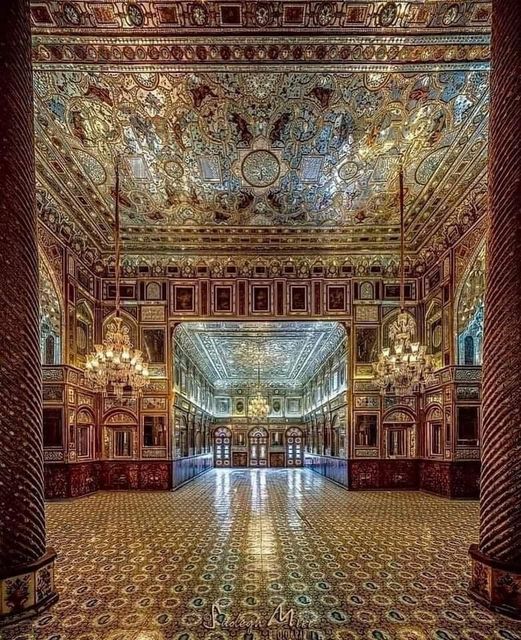Nestled in the heart of Tehran, Iran’s capital city, the Golestan Palace stands as an enduring monument to the country’s rich heritage and artistic genius. This UNESCO World Heritage Site is not merely a royal residence frozen in time—it is a living testament to centuries of Persian history, culture, and architectural evolution. Through its grand halls, exquisite gardens, and intricate designs, the palace offers an immersive journey into the world of Iranian royalty and the artistry that defined generations. It is a place where political history and creative brilliance seamlessly merge, leaving an indelible impression on all who walk its storied grounds.

The roots of Golestan Palace stretch back to the Safavid dynasty of the 16th century, a period of cultural revival and national pride. Originally conceived as a modest royal complex, the palace began to transform during the Qajar era in the 19th century, when it reached the height of its grandeur. It was during this time that Golestan truly flourished, embodying the lavish lifestyle and refined tastes of Persian monarchs. The name “Golestan,” meaning “Rose Garden,” is a fitting tribute to the palace’s lush, serene gardens that provide a peaceful escape from the bustling city that surrounds it. These gardens were not merely ornamental; they served as vital gathering spaces for relaxation, diplomacy, and contemplation, embodying the Persian ideal of harmony between nature and architecture.
As visitors step through the palace gates, they are met with a breathtaking blend of Persian tradition and European influence, an architectural dialogue that emerged during Iran’s increased contact with the West in the 19th century. Golestan Palace is a masterpiece where Eastern elegance meets Western innovation. Traditional Persian tilework—rich in color and symbolic patterns—coexists with elements such as French stained glass and baroque-inspired structures, creating a captivating visual experience. Every wall, ceiling, and column tells a story of artistic exchange, technical mastery, and cultural curiosity. The ornate mirror work, carved marble, and hand-painted murals reflect not only the aesthetics of the time but also the dedication of countless artisans whose work has withstood the passage of centuries.
One of the most celebrated spaces within the palace is the Hall of Mirrors, a room that defies description in its brilliance. Covered entirely in small, carefully placed mirrors, the room captures and multiplies every glimmer of light, creating a dazzling, almost otherworldly spectacle. It was within these luminous walls that kings held court, entertained dignitaries, and hosted grand celebrations. The Hall of Mirrors was designed not only to impress but to symbolize power, refinement, and divine light—a concept deeply rooted in Persian philosophy. As sunlight filters through the windows and reflects in countless directions, visitors today can still feel the echoes of royal banquets and state ceremonies that once filled the air with opulence and grandeur.
Adjacent to this spectacle lies the Sun Chamber, another architectural gem within the Golestan complex. Defined by its graceful arches, ornate furnishings, and warm natural light, the Sun Chamber served as an intimate setting for private gatherings and moments of royal leisure. Every detail within this space—from the handwoven carpets to the elaborate ceiling patterns—speaks to the meticulous care and artistic vision of Persian craftsmen. Here, elegance is not just a visual experience; it is a feeling that envelops every visitor, transporting them to a time when artistry and function were harmoniously entwined.
However, Golestan Palace is far more than a collection of beautiful rooms. It is a silent witness to some of Iran’s most pivotal historical events. During the early 20th century, the palace played a role in the Constitutional Revolution, a movement that redefined Iran’s political landscape and marked a shift toward modern governance. As such, the palace occupies a unique position in Iran’s historical narrative—it is both a symbol of royal authority and a backdrop to revolutionary change. Its walls have borne witness to moments of both splendor and struggle, making it not only a cultural landmark but a political one as well.
Today, Golestan Palace continues to thrive, not as a seat of power but as a beacon of cultural preservation. It welcomes visitors from across the globe, each seeking to connect with the artistry and history embedded within its walls. The palace regularly hosts exhibitions, educational programs, and cultural events, ensuring that its legacy is not only remembered but celebrated. Through these efforts, Golestan Palace has become more than a historical site—it is a dynamic cultural center that nurtures appreciation for Persian heritage and fosters dialogue among past, present, and future generations.
In conclusion, Golestan Palace stands as a timeless jewel in the crown of Iranian cultural heritage. It is a place where the echoes of the past resonate through every mirrored hall and every blossoming garden. The palace’s unique blend of architectural styles, its role in shaping and witnessing history, and its ongoing cultural relevance make it an invaluable treasure, not only for Iran but for the world. As sunlight continues to dance across its intricately decorated surfaces and the soft rustle of leaves fills its rose gardens, Golestan Palace remains a powerful symbol of Persian resilience, beauty, and the enduring spirit of a civilization that has contributed immeasurably to the world’s cultural legacy. For all who visit, it offers a profound and unforgettable glimpse into a world where history, art, and nature coalesce in breathtaking harmony.





